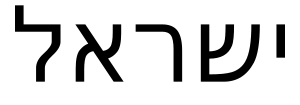Hebrew language facts for kids
Quick facts for kids Hebrew |
|
|---|---|
| עִבְרִית ʿIvrit | |
| Pronunciation | - |
| Native to | Israel, Jewish communities in Judea and Samaria; used globally as a liturgical language for Judaism |
| Native speakers | 5.3 million (1998) |
| Language family | |
| Writing system | Hebrew alphabet Hebrew Braille |
| Official status | |
| Official language in | |
| Regulated by | Academy of the Hebrew Language האקדמיה ללשון העברית (HaAkademia LaLashon HaʿIvrit) |
| Linguasphere | 12-AAB-a |
The Hebrew language is a very old language. It belongs to a group of languages called Semitic languages. Hebrew is mainly spoken by Jewish people around the world. The Academy of the Hebrew Language helps keep the language alive and growing.
Hebrew was first spoken by the Israelites many, many years ago, during the time the Bible was written. For a long time, people mostly used Hebrew for religious studies and prayers. It wasn't used much for everyday talking.
In the 20th century, many Jewish people decided to bring Hebrew back as a spoken language. This was a big part of creating the country of Israel in 1948. People from different countries came to Israel and learned Hebrew. This helped them all communicate using one common language. Today's Hebrew, called Modern Hebrew, is a bit different from the ancient Biblical Hebrew. It has simpler grammar and uses many words borrowed from languages like English.
If you want to read the Bible in its original form, you would need to learn Biblical Hebrew. Hebrew is similar to the Arabic language in some ways. Hebrew words are often made by combining a root with a pattern.
How Hebrew Works
Hebrew words are built in an interesting way. They often start with a "root" of three letters. Then, different patterns are added to this root to create new words. For example, a root might mean "write," and adding different patterns can make it mean "he wrote," "she writes," or "a book."
Modern Hebrew has borrowed words from many European languages. These include English, French, German, and Russian. Also, many old words from the Old Testament were given new meanings in modern Hebrew.
Grammar Basics
Learning Hebrew grammar helps you read correctly, especially since vowels aren't always written. In Modern Hebrew, there's no verb "to be" in the present tense. For example, you wouldn't say "I am a student" with a verb "am." Instead, you'd say "I student." The verb "to be" is only used in the future and past tenses.
Older forms of Hebrew, like Biblical Hebrew, didn't use tenses like "past," "present," or "future." Instead, they used "aspects." These aspects showed if an action was completed or ongoing. For example, one aspect might be like the past tense, showing something finished. Another might be like the present or future, showing something still happening.
Mishnaic Hebrew was spoken around the time of Jesus. It was used until about the 6th century AD.
Hebrew and Yiddish
The Hebrew alphabet is also used to write Yiddish. Yiddish is another Jewish language. However, Yiddish sounds very different from Hebrew. This is because Yiddish comes from the same language family as German.
Alphabet
The Hebrew alphabet has 22 letters. These letters are all consonants. Five of these letters change their shape when they appear at the very end of a word. Hebrew is read from right to left, which is the opposite of English.
The Hebrew alphabet is an abjad. This means that usually, only the consonants are written down. The reader has to figure out the vowels themselves. This can be tricky! To help, sometimes small dots and dashes, called niqqud (pronounced "nee-KOOD"), are added above or below the letters to show the vowels. In Modern Hebrew, some letters can also act as vowels. These are called matres lectionis, which means "mothers of the reading," because they help a lot with reading.
| Aleph | Bet | Gimel | Dalet | He | Waw | Zayin | Heth | Teth | Yodh | Kaf |
|---|---|---|---|---|---|---|---|---|---|---|
| א | ב | ג | ד | ה | ו | ז | ח | ט | י | כ |
| ך | ||||||||||
| Lamed | Mem | Nun | Samekh | Ayin | Pe | Tsadi | Kuf | Resh | Shin | Taw |
| ל | מ | נ | ס | ע | פ | צ | ק | ר | ש | ת |
| ם | ן | ף | ץ |
Images for kids
-
Aleppo Codex: 10th century Hebrew Bible with Masoretic pointing (Joshua 1:1).
-
Kochangadi Synagogue in Kochi, India dated to 1344.
-
Hebrew, Arabic and English multilingual signs on an Israeli highway
See also
 In Spanish: Idioma hebreo para niños
In Spanish: Idioma hebreo para niños










